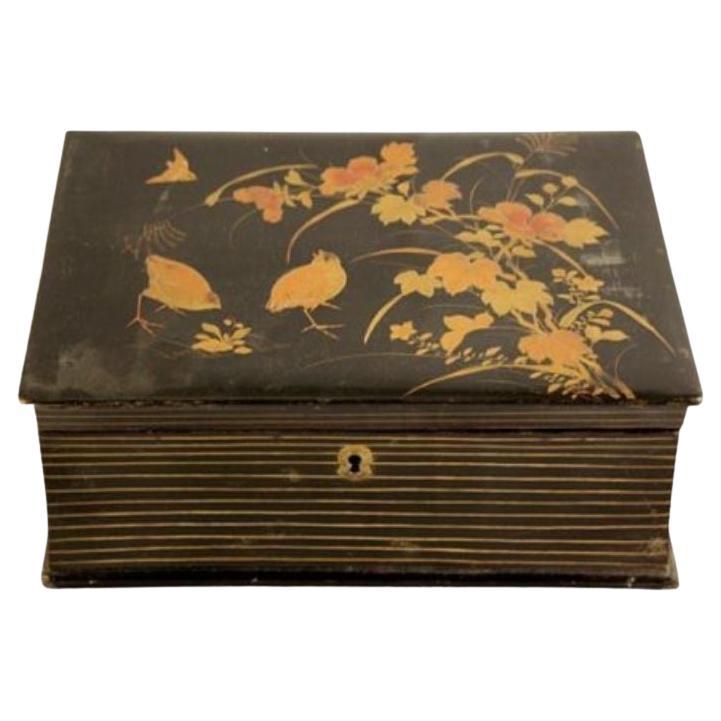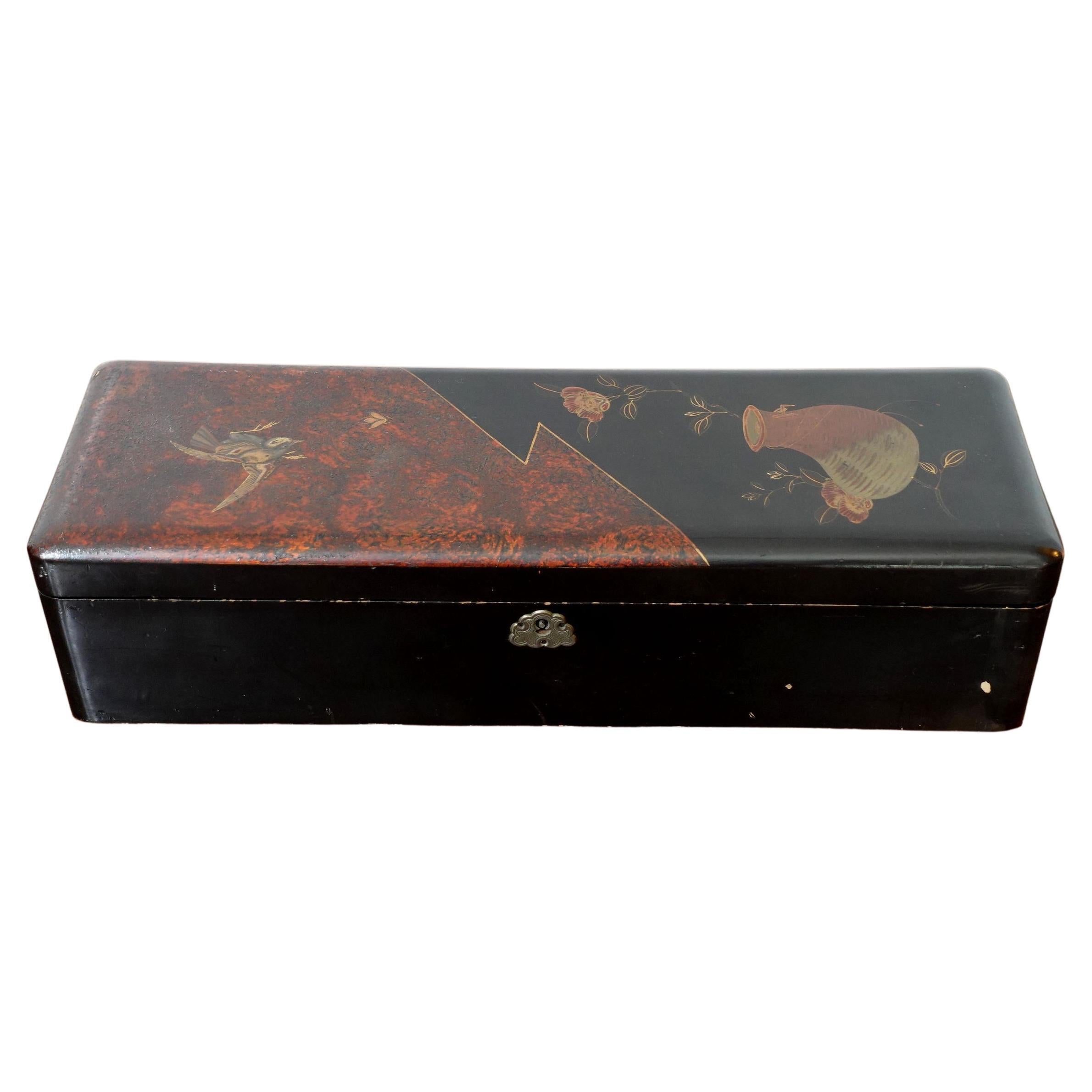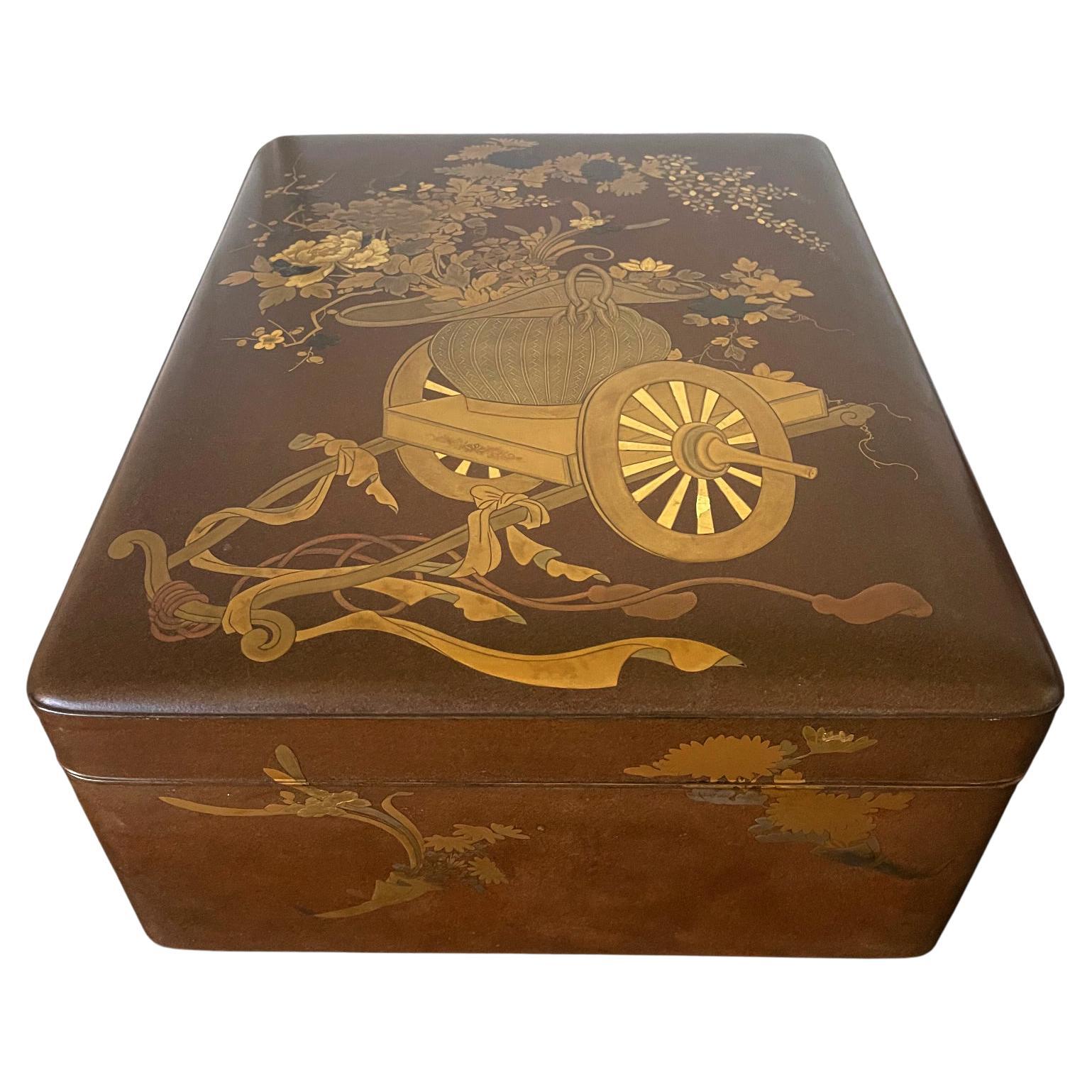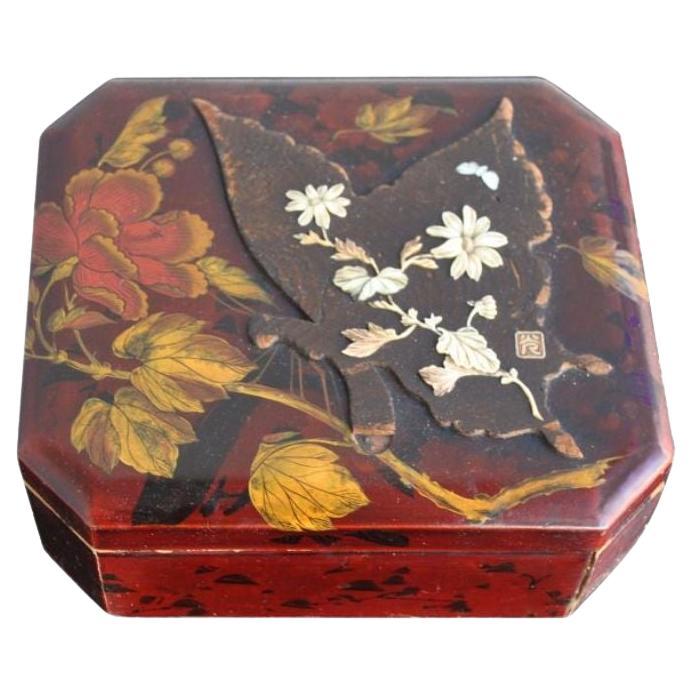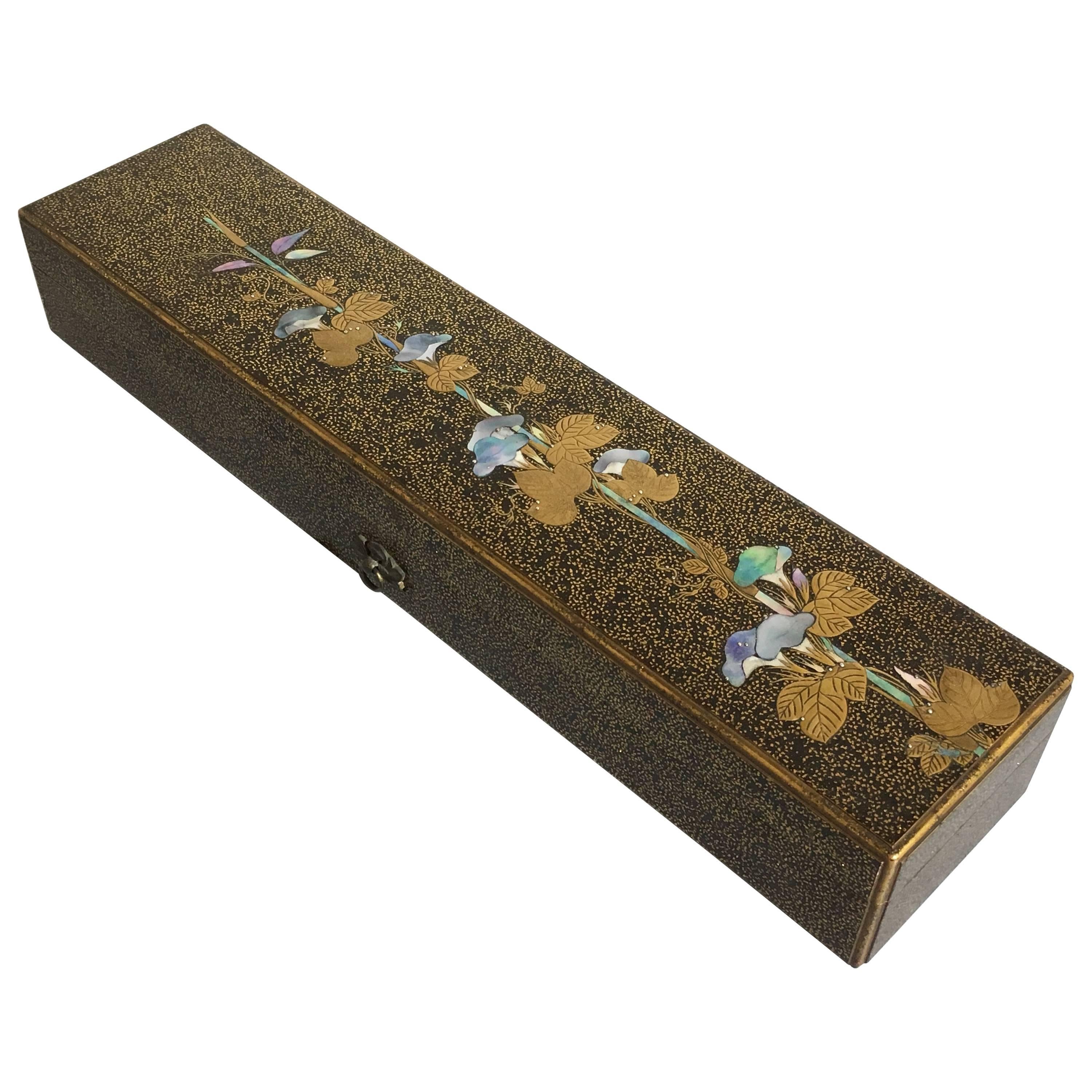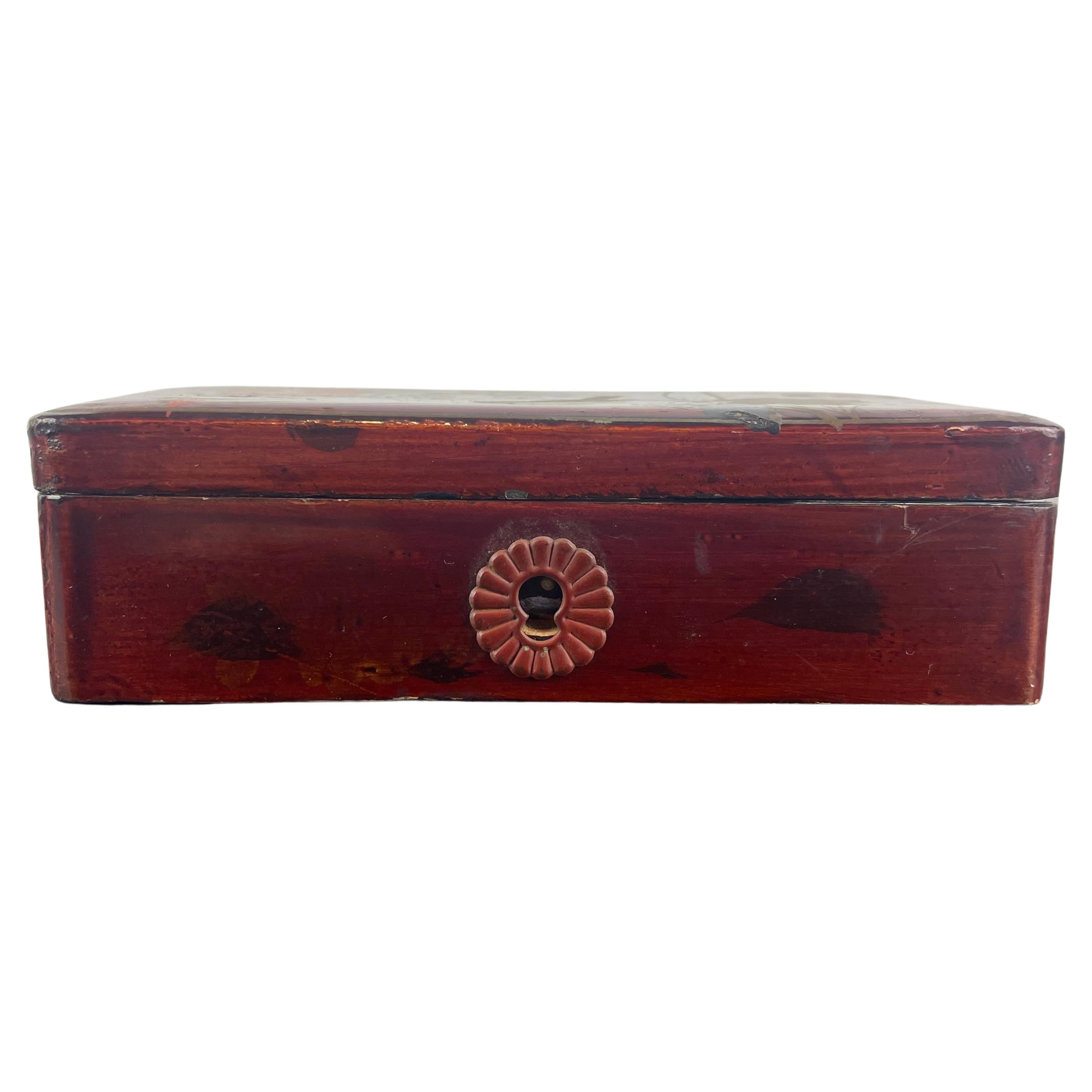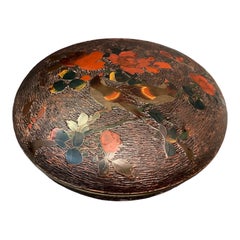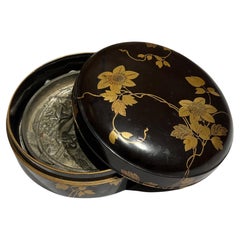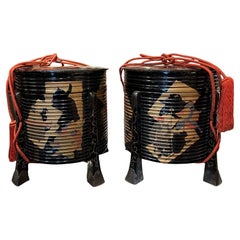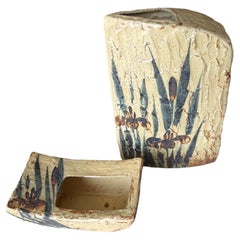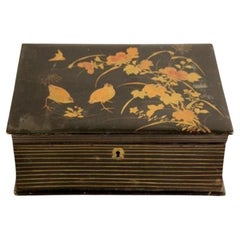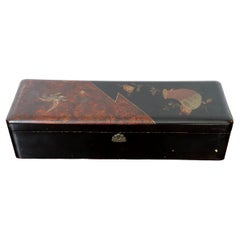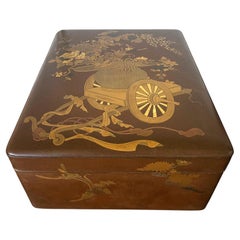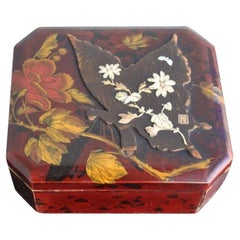Items Similar to Box signed Katsutoshi Koku, Japan, Meiji period (1868-1912)
Video Loading
Want more images or videos?
Request additional images or videos from the seller
1 of 11
Box signed Katsutoshi Koku, Japan, Meiji period (1868-1912)
$2,243.99
£1,681.45
€1,900
CA$3,150.80
A$3,453.18
CHF 1,803.32
MX$41,434.22
NOK 22,643.74
SEK 21,329.56
DKK 14,471.91
About the Item
Box signed Katsutoshi Koku, Japan, Meiji period (1868-1912)
Rectangular silver box bearing the Japanese junjin hallmark, signifying pure silver, made during the Meiji period (1868-1912) and signed Katsutoshi Koku.
The lid, crafted in shibuichi, an alloy of silver and copper, is delicately adorned with an engraved design inlaid with precious metals, depicting a naturalistic scene of a pair of pheasants by a lakeside. Rendered with great finesse, this motif evokes the compositions of the painter Ohara Koson (1877-1945), renowned for his depictions of Japanese wildlife and landscapes. The artist primarily employed the kata-kiri-bori technique, a beveled engraving method that allows for variations in line thickness, creating a pictorial effect reminiscent of ink painting. The metalwork, enhanced with takabori (relief carving) and inlays, reveals a play of textures and reflections that imbue the composition with a sense of depth and movement.
The interior of the box, as well as the inside of the lid and the bottom, are covered in nashiji lacquer, a refined finish characterized by the inclusion of fine gold particles within the lacquer, creating a shimmering and silky effect. This choice reflects meticulous attention to detail, elevating the piece beyond mere functionality to a level of elegance and sophistication.
Exemplifying remarkable craftsmanship, this box is part of the production of Japanese art objects designed for a discerning clientele, both domestic and international. Through the harmony of its materials and the precision of its engraving, it illustrates the expertise of Meiji-era metalworkers, demonstrating their ability to blend tradition and innovation in metal art.
Dimensions: 5 x 13.5 x 10.5 cm.
Glossary of Metal Engraving Techniques:
• Takabori (relief carving): A carving technique where the motifs are slightly raised from the surface.
• Nunome-zogan: The inlaying of gold and silver threads or plates into a base metal (often bronze or shibuichi).
• Kata-kiri-bori: An engraving technique that mimics ink painting by using lines of varying thickness.
• Materials used by artisans: Shibuichi (silver and copper alloy), shakudo (gold and copper alloy), iron, and bronze.
- Dimensions:Height: 5.52 in (14 cm)Width: 1.97 in (5 cm)Depth: 4.14 in (10.5 cm)
- Materials and Techniques:
- Place of Origin:
- Period:
- Date of Manufacture:1890
- Condition:Wear consistent with age and use.
- Seller Location:PARIS, FR
- Reference Number:1stDibs: LU6491243823542
About the Seller
5.0
Recognized Seller
These prestigious sellers are industry leaders and represent the highest echelon for item quality and design.
Established in 1982
1stDibs seller since 2022
7 sales on 1stDibs
- ShippingRetrieving quote...Shipping from: PARIS, France
- Return Policy
Authenticity Guarantee
In the unlikely event there’s an issue with an item’s authenticity, contact us within 1 year for a full refund. DetailsMoney-Back Guarantee
If your item is not as described, is damaged in transit, or does not arrive, contact us within 7 days for a full refund. Details24-Hour Cancellation
You have a 24-hour grace period in which to reconsider your purchase, with no questions asked.Vetted Professional Sellers
Our world-class sellers must adhere to strict standards for service and quality, maintaining the integrity of our listings.Price-Match Guarantee
If you find that a seller listed the same item for a lower price elsewhere, we’ll match it.Trusted Global Delivery
Our best-in-class carrier network provides specialized shipping options worldwide, including custom delivery.More From This Seller
View AllLarge Japanese Cloisonné Box and Cover, Japan, Meiji Period, 19th Century
Located in PARIS, FR
A rare Japanese bark tree large cloisonné box on metal from the Meiji period. Usually bark tree cloisonné was on porcelain (totai Shippo)
A very attracti...
Category
Antique Late 19th Century Japanese Metalwork
Materials
Metal
$2,480 Sale Price
25% Off
Japanese Cast Bronze Mirror and lacqer box, Edo Period, 18th Century, Japan
Located in PARIS, FR
A heavy and finely cast Japanese bronze mirror decorated with pines , cranes wich are longevity symbols, The handle in the center is a a tutle which also symbolize longevity.
Edo Period, 18th century, Japan.
The small, round mirror with high walls has been intricately and exquisitely cast with symbols . The turtle has a domed shell pieced to allow a cord to be strung through for handling or hanging.
A five charactesr mark is cast on the border.
Mirror is 12 ,3 x 1,6 cm
Box is 14,2 x 5 cm
Surrounding the turtle and inscription is a densely cast landscape featuring pine trees with fantastic needles, two cranes with their 3 youngs, dense stalks of leafy bamboo. and a blooming prunus on the left side.
All are symbols of longevity. Bamboo also symbolizes resilience and prosperity. Bamboo asociated with prunus and pine are called the 3 frinds of winter.
The other side of the mirror is undecorated, and would originally have been highly polished, allowing the user to see their reflection in the polished surface.
The bronze with a wonderful, warm silver patina.
This mirror is presented in its original lacquer box , hand decorated in the Kodaiji style with gold lacquer flowers...
Category
Antique Late 18th Century Japanese Japonisme Metalwork
Materials
Bronze
$1,181 Sale Price
20% Off
Japan, Pair of Hokai boxes in lacquered wood, Edo period, 1829
Located in PARIS, FR
Japan, Pair of Hokai boxes in lacquered wood, Edo period, 1829
Japan, Rare Pair of Hokai boxes in lacquered wood, Edo period, dated Bunsei 12, 1829.
Hokai boxes are traditionally use...
Category
Antique 19th Century Japanese Chinoiserie Decorative Boxes
Materials
Lacquer
Japan, Set of Two Japanese Vases for Flower Arrangement, Ikebana
Located in PARIS, FR
Rare ceramic set of hand made vases Japanese flower arrangements. Very attractive even without flowers.
Hand made, hand painted and signed by the ar...
Category
Mid-20th Century Japanese Vases
Materials
Ceramic
Chinese Cinabar Lacquer Hand Carved Box, China, Qing Dynasty 19th c.
Located in PARIS, FR
A fine antique Chinese red cinnabar lacquer lidded round box carved with a scene with a man working and a mother holding a child within a rocky landscape with trees.
The "dragon's...
Category
Antique Mid-19th Century Decorative Boxes
Materials
Lacquer
$2,362 Sale Price
20% Off
Japan, Rare Vase by Kanzan Shinkai, born in 1912
Located in PARIS, FR
Vase by Kanzan Shinkai,born in 1912
This vase is a fine example of Kanzan Shinkai's work. It features an intricate design, with raised circular patterns, using contrasting colors suc...
Category
Mid-20th Century Japanese Vases
Materials
Ceramic
You May Also Like
Japanese Lacquer Box, 1900
Located in Marseille, FR
Japanese lacquer box 1900 decorated with sparrows, gold lacquer on a black background of very good quality, good general condition. The dimensio...
Category
Antique 19th Century Decorative Boxes
Materials
Lacquer
Japanese Maki-e Lacquered Box, Ric.049
Located in Norton, MA
Japan, Edo to Meiji period, a long rectangular document box with hinged cover, decorated with a bird and a floral basket,
The locker is not functioning.
Category
Antique 19th Century Japanese Decorative Boxes
Materials
Lacquer
Japanese Lacquer Ryoshibako Document Box Meiji Period
Located in Atlanta, GA
A large Japanese lacquer box with elaborate Maki-e design from Meiji period, (mid-late 19th century). The generous size of the box was reser...
Category
Antique 19th Century Japanese Japonisme Lacquer
Materials
Wood, Lacquer
Antique Japanese Lacquer Jewelry Box Towards the End of the 19th Century
Located in Marseille, FR
Antique Japanese lacquer jewelry box from the late 19th century decorated with flowers and foliage, 8 cm high for a length of 21 c...
Category
Antique Late 19th Century Jewelry Boxes
Materials
Lacquer
Japanese Edo Period Igarashi School Long Lacquer Box, Tanzaku-Bako
Located in Austin, TX
A stunning Japanese Edo period lacquer tanzakubako, box for poem cards, late 18th-early 19th century, Edo Period, Japan.
Attributed to the Igarashi School, this box is masterfully ...
Category
Antique Early 19th Century Japanese Edo Lacquer
Materials
Mother-of-Pearl, Lacquer
Japanese Lacquered Box Signed, Late 19th Century
Located in Beuzevillette, FR
Pretty Japanese lacquered box decorated with birds and foliage.
signed
Lacquered inside and outside
Late 19th century
Without key
Nice lock
Ideal for storing jewelry.
Category
Antique Late 19th Century Japanese Decorative Boxes
Materials
Wood
More Ways To Browse
Silver Antique Japanese Boxes Silver Boxes
Japanese Landscape Artist
Cherry Wood Box
Chinese Jade Box
Cloisonne Brass Box
French Crate
French Perfume Box
Gold Powder Box
Inlaid Bone Decorative Boxes
Macassar Ebony Box
Russian Lacquer Box
Small Sterling Silver Objects
Tortoise Mother Of Pearls
Valuables Box
Vintage Hinged Box
Walnut Sewing Box
Antique Porcelain Trinket Boxes
Betel Nut Boxes
